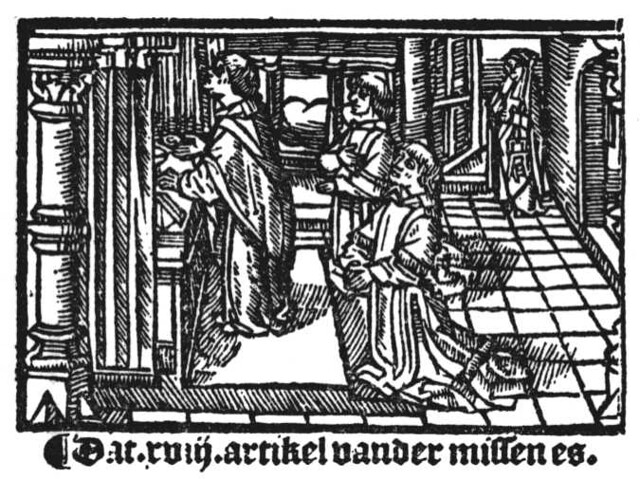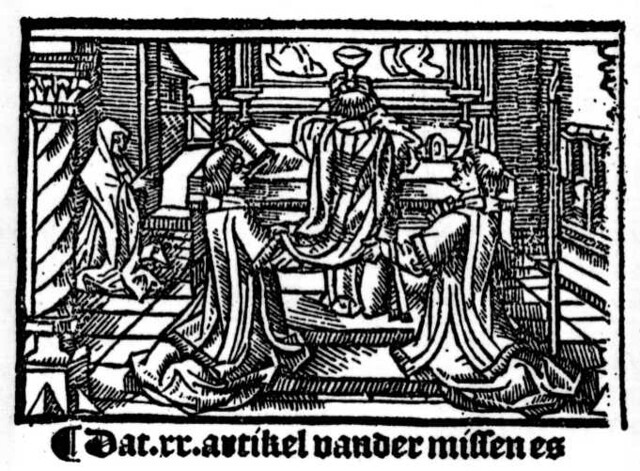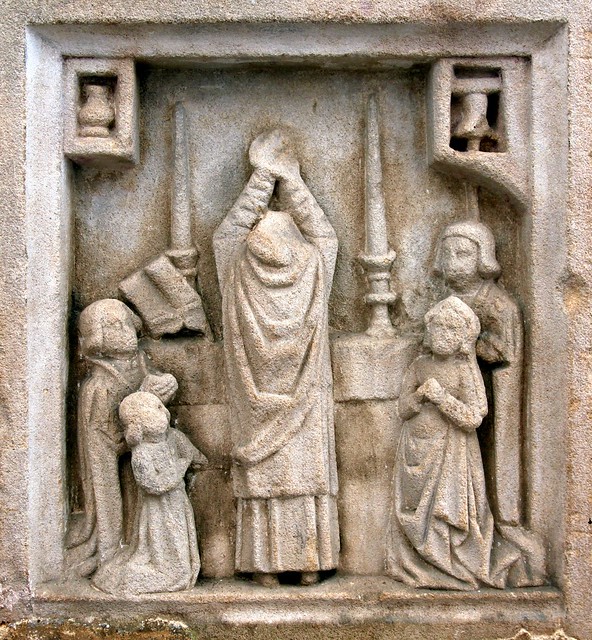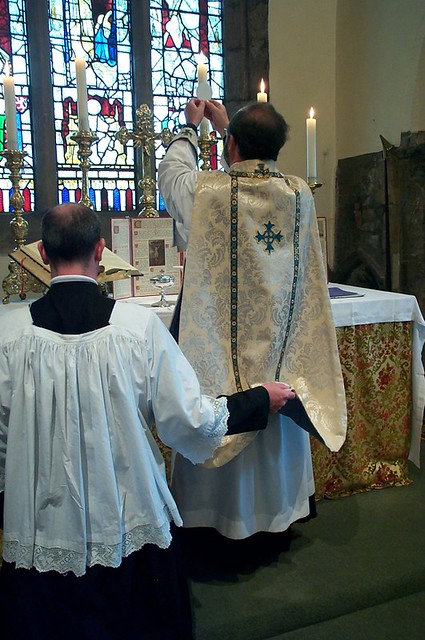'the minister lifts the chasuble on his shoulder' - the adjustment of the Chasuble during the late medieval mass
In 1903 Percy Dearmer edited for the Alcuin Club, a facsimile of an extraordinary early sixteenth century treatise. Dat Boexken Vander Missen or the Booklet of the Mass, is a treatise on the purpose of the Mass and of its ceremonial. Written in Old Dutch, it was said to have been written by an Observant Friar called Gherit Vander Goude (Gerard of Gouda) and the earliest surviving old Dutch edition was printed in 1506 in Antwerp by Adrian van Bergen Part of it consists of a block-book, in which the ceremonial of the mass is divided into thirty three articles, illustrated by thirty seven extraordinary woodcuts which show in great detail the different ceremonial elements of the mass. In the intense religious environment of northern Europe there was a ready market for such a book, there were old Dutch editions in 1506 and 1507, a French edition in 1528, an English edition in 1532 and a Flemish edition in 1538.


If you don't believe me that the action of folding the chasuble over the shoulders is meant here, look at the illustrations for article twenty of Dat Boexken, the illustration of the the elevation of the chalice. It is evident as the priest elevates the chalice, that the sides of the chasuble have indeed been folded over the shoulders to free the arms.
I said earlier that this ritual recorded in Dat Boexken was a common piece of ritual, but how do I know that? Well there is ample late medieval visual evidence to prove that the this little bit of ceremonial is not just some obscure bit of Dutch liturgy, but was common practice in many parts of Northern Europe.
The font at Cley is a very clear example, with arms of the priest free as he elevates the host. The best is perhaps the font at Westhall in Suffolk, which still retains traces of colour and where the red lining of the chasuble is revealed.

The article within Dat Boexken that I'm interested in drawing to your attention today, is the eighteenth article, which describes the ceremonial preparation for the consecration of the oblations of bread and wine at mass. The woodcut illustration (above) shows the Priest at the altar, holding the Host in his right hand, with his assistants the Deacon and Subdeacon kneeling on the step below. However, the caption describes other actions in addition to those that are illustrated. This is Dearmer's translation of the Old Dutch caption:
'How the priest takes the Host in his hand, and the minister lifts the chasuble from his shoulder, and then the priest prepares himself to consecrate and to offer the Holy Sacrament of the Body of our Lord'.I want to focus more closely on one bit of this text and bring to your attention this clause: 'the minister lifts the chasuble from his shoulder, and the prepares himself to consecrate'. To start with I think Dearmer has actually mistranslated the Old Dutch here. The Old Dutch which Dearmer translates as 'from his' are the words 'op sÿn'. Dearmer has I think got this wrong, these words don't mean 'from his', but rather 'on his'. So the bit of the caption that I want to focus on is this
'the minister lifts the chasuble on his shoulder, and prepares himself to consecrate'.What appears to be described is a common, but rather obscure bit of ceremonial, that is missed out of the rubrics of the Missals. Incidentally those acquainted with the rubrics of medieval Missals will not be surprised at such an omission, the rubrics are sparse. In the later Middle Ages the chasuble worn by the priest was still in its full form. In order for the priest to be prepared to perform the manual acts and also the elevation of the Host and chalice, which necessitates the raising of the arms, there is a brief pause to ensure that the chasuble is not in the way. Dat Boexken suggests that the sides of the chasuble were folded neatly over the shoulders of the Priest. The fact that the word 'minister' is used to describe the person doing this, while the word priest is used to describe the priest's actions, suggests that the Deacon or Subdeacon undertook this role. In fact it's difficult to see how the Priest could perform this himself without some assistance.

If you don't believe me that the action of folding the chasuble over the shoulders is meant here, look at the illustrations for article twenty of Dat Boexken, the illustration of the the elevation of the chalice. It is evident as the priest elevates the chalice, that the sides of the chasuble have indeed been folded over the shoulders to free the arms.
I said earlier that this ritual recorded in Dat Boexken was a common piece of ritual, but how do I know that? Well there is ample late medieval visual evidence to prove that the this little bit of ceremonial is not just some obscure bit of Dutch liturgy, but was common practice in many parts of Northern Europe.
From a French context we have this illustration of the Mass of St Gregory from the early sixteenth century Hours of Henry VIII in the Morgan Library in New York. The saint is wearing a gold chasuble, which has been turned over his shoulders to reveal a green lining.
Then from a Netherlandish context, there is the superlative image of the Mass of St Giles, which shows St Giles celebrating mass in St Denys in Paris. His chasuble, captured in such great detail, appears to be of black velvet, but the luscious pink lining of the vestment is revealed, because the material of the chasuble is folded over the shoulders. The folding shown here cannot be the consequence of the priest getting himself caught up wrongly in the vestment, but only through deliberate placement.
Then from an English context we have some of the delightful images of the mass from Seven Sacrament fonts. The font at Gresham in Norfolk, seems to show the celebrant, a bishop, with a folded chasuble.
How long this informal ceremony persisted is quite unclear. The chasuble of course evolved on the continent from the full medieval form into the Latin form (image above), which in effect is a form of the chasuble with all the excess material that was once folded over the shoulder, permanently removed. That change would have rendered the action obsolete.





Comments
Thanks for your post! I just found your blog but I really enjoy its combination of history and architecture.